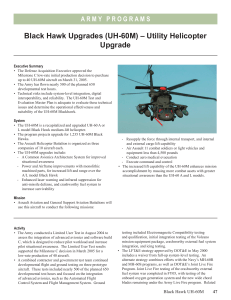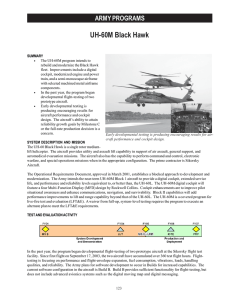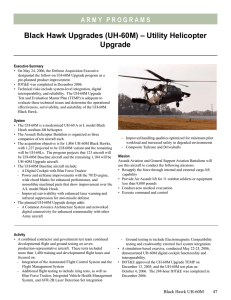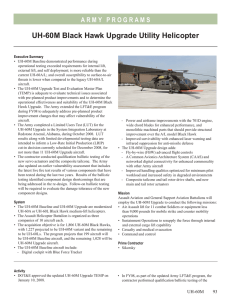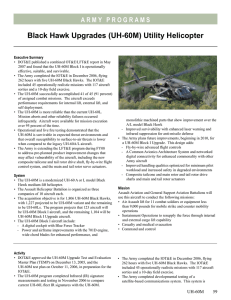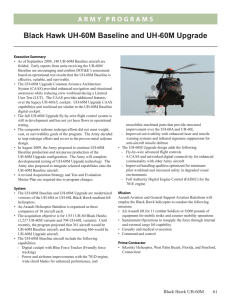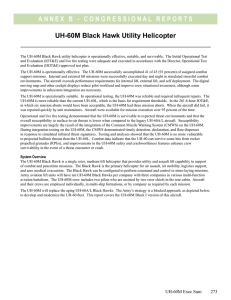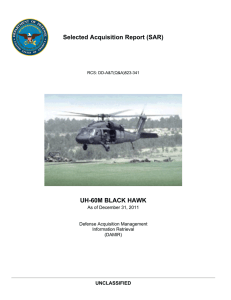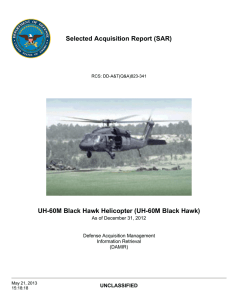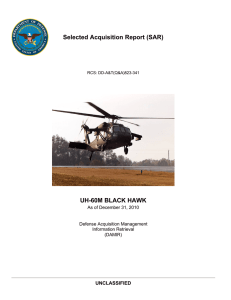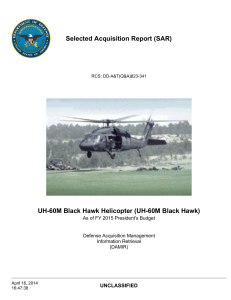T UH-60M Black Hawk ARMY PROGRAMS
advertisement
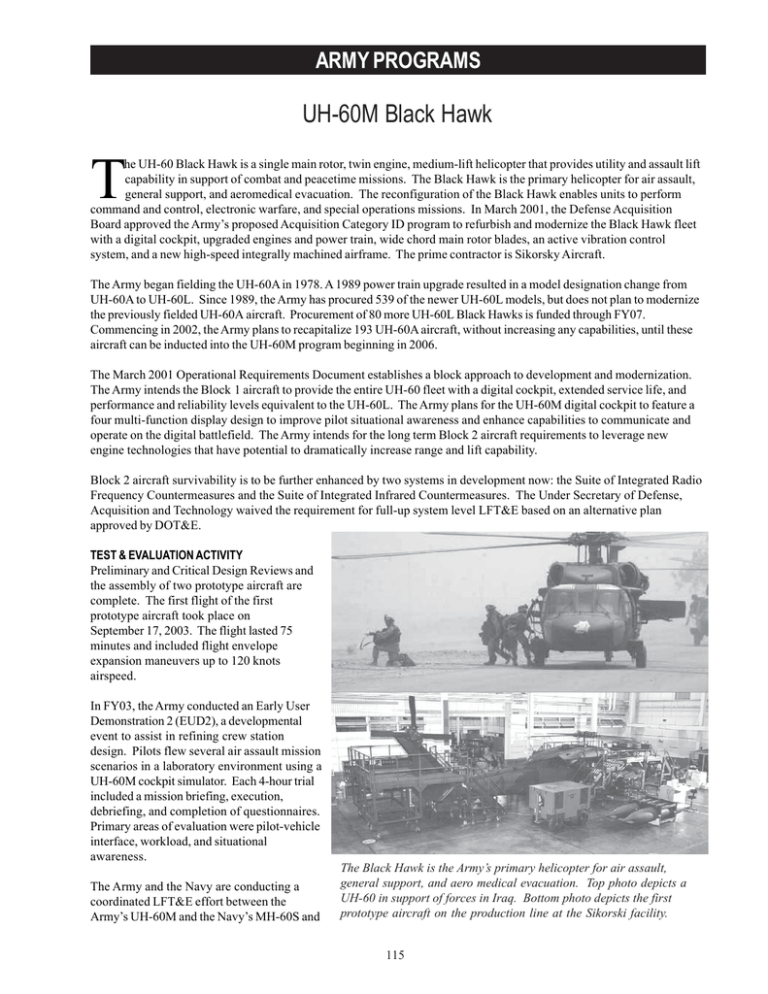
ARMY PROGRAMS UH-60M Black Hawk T he UH-60 Black Hawk is a single main rotor, twin engine, medium-lift helicopter that provides utility and assault lift capability in support of combat and peacetime missions. The Black Hawk is the primary helicopter for air assault, general support, and aeromedical evacuation. The reconfiguration of the Black Hawk enables units to perform command and control, electronic warfare, and special operations missions. In March 2001, the Defense Acquisition Board approved the Army’s proposed Acquisition Category ID program to refurbish and modernize the Black Hawk fleet with a digital cockpit, upgraded engines and power train, wide chord main rotor blades, an active vibration control system, and a new high-speed integrally machined airframe. The prime contractor is Sikorsky Aircraft. The Army began fielding the UH-60A in 1978. A 1989 power train upgrade resulted in a model designation change from UH-60A to UH-60L. Since 1989, the Army has procured 539 of the newer UH-60L models, but does not plan to modernize the previously fielded UH-60A aircraft. Procurement of 80 more UH-60L Black Hawks is funded through FY07. Commencing in 2002, the Army plans to recapitalize 193 UH-60A aircraft, without increasing any capabilities, until these aircraft can be inducted into the UH-60M program beginning in 2006. The March 2001 Operational Requirements Document establishes a block approach to development and modernization. The Army intends the Block 1 aircraft to provide the entire UH-60 fleet with a digital cockpit, extended service life, and performance and reliability levels equivalent to the UH-60L. The Army plans for the UH-60M digital cockpit to feature a four multi-function display design to improve pilot situational awareness and enhance capabilities to communicate and operate on the digital battlefield. The Army intends for the long term Block 2 aircraft requirements to leverage new engine technologies that have potential to dramatically increase range and lift capability. Block 2 aircraft survivability is to be further enhanced by two systems in development now: the Suite of Integrated Radio Frequency Countermeasures and the Suite of Integrated Infrared Countermeasures. The Under Secretary of Defense, Acquisition and Technology waived the requirement for full-up system level LFT&E based on an alternative plan approved by DOT&E. TEST & EVALUATION ACTIVITY Preliminary and Critical Design Reviews and the assembly of two prototype aircraft are complete. The first flight of the first prototype aircraft took place on September 17, 2003. The flight lasted 75 minutes and included flight envelope expansion maneuvers up to 120 knots airspeed. In FY03, the Army conducted an Early User Demonstration 2 (EUD2), a developmental event to assist in refining crew station design. Pilots flew several air assault mission scenarios in a laboratory environment using a UH-60M cockpit simulator. Each 4-hour trial included a mission briefing, execution, debriefing, and completion of questionnaires. Primary areas of evaluation were pilot-vehicle interface, workload, and situational awareness. The Army and the Navy are conducting a coordinated LFT&E effort between the Army’s UH-60M and the Navy’s MH-60S and The Black Hawk is the Army’s primary helicopter for air assault, general support, and aero medical evacuation. Top photo depicts a UH-60 in support of forces in Iraq. Bottom photo depicts the first prototype aircraft on the production line at the Sikorski facility. 115 ARMY PROGRAMS MH-60R to reduce costs and compress the schedule. The testing to date includes ballistic testing of several flight-critical main rotor drives, flight control components, and the entire fuel system under static and dynamic load conditions. The program is procuring several damaged Army and Navy H-60 aircraft, and a fully operational, but not flight worthy, YCH60 prototype that is serving as the production representative ground test vehicle. The Army is updating earlier vulnerability models to be more representative of the latest design configuration. TEST & EVALUATION ASSESSMENT Technical risks for the UH-60M program include the structural design of the airframe and software integration. The DOT&E-approved UH-60M test program will provide ample opportunity to evaluate these technical issues and determine the operational effectiveness and suitability of the UH-60M helicopter. Until the prototype aircraft flight-testing is complete, the adequacy of the UH-60M structural design will not be validated. It is possible that unexpected fatigue, dynamic, or vibration loads could be encountered in the newly designed airframe. Software development and integration issues remain with the processor throughput for some subsystems. The aircraft system computer resource utilization is desired to be less than 50 percent. However, three subsystems exceed the 50 percent utilization goal in the program. The EUD2 demonstrates that pilots in the UH-60M cockpit can perform today’s air assault mission. Pilot vehicle interfaces are adequate with the exception of free text messaging procedures. The messaging procedures are not intuitive and are time-consuming, requiring the copilot to remain focused inside the cockpit for extended periods of time. With respect to workload levels, pilots report that they retain the capacity to perform all desirable additional tasks when operating in the new cockpit. Pilot situational awareness is enhanced by the navigation aids and digital map display systems. The integrated Army/Navy LFT&E plan takes into account vulnerability reduction features that were incorporated into the Black Hawk since its initial fielding in 1978, combat damage experience, subsystem qualification efforts, computer modeling and simulation, as well as other Services’ testing. Test results show improved survivability over prior H-60 model aircraft. 116
